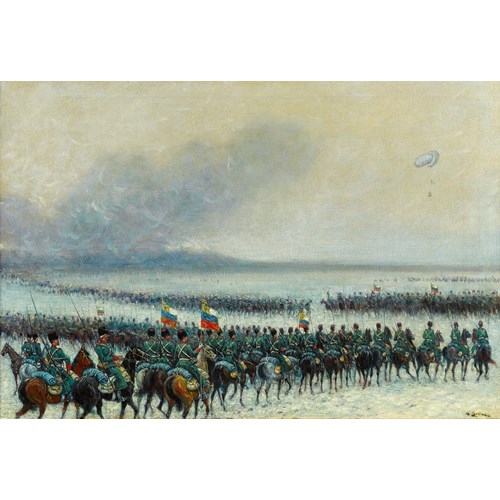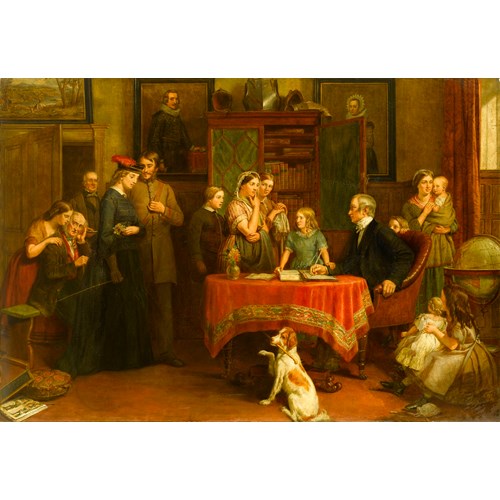Marketplace
Hunting with Borzoi
Pyotr Petrovich Sokolov
Hunting with Borzoi
Date 1890
Epoque 1850-1900, 19th century
Origine Russia
Medium Pen, Brush, Black ink, Gouache on paper
Dimension 45 x 63.5 cm (17³/₄ x 25 inches)
In this dark and expressive drawing, Pyotr Petrovich Sokolov offers a snapshot of an exhilarating wolf hunt. In an almost wholly monochromatic palette, Hunting with Borzoi is set in a wild and sparse landscape, the sharp accentuated brushstrokes of the artist emphasising the harshness of this Russian hunting steppe and the drama of the event. Three athletic borzoi, or Russian wolfhounds, surround a small, panicked wolf cub. Their lean and athletic bodies, built purely for speed, provide too stern a match for the helpless wolf. Two further borzoi dash from the scrubland towards their prey, trapping it and dispelling any thought that it might escape. A burly hunter on horseback, stands tall in the stirrups of his horse, watching carefully. The dark intensity of the horse’s eye captures the adrenaline and exhilaration of the chase. The hunter holds in his left hand a trailing rope, waiting to tie the wolf down; in his right he tightly grips both his crop and the reins.
Hunting was a recurring theme in Sokolov’s work, which he explored in a variety of mediums throughout his career. The Tretyakov’s Wolf Hunting, lacks the dynamism of the present work but still bristles with the energy of the pack. In the Tretyakov’s painting the hunt is now over and the borzoi patrol around the captured wolf, the dogs’ lithe athletic bodies contrasting with the elegance of the horse. However, there is still a sense of the potential power of the pack, and it is the energy of the hunt which led to Sokolov returning repeatedly to the subject.
In Tsarist Russia, before the Emancipation reform of 1861, wolf hunting was a pursuit reserved solely for the aristocracy and rich landowners. However, upon learning of the frequency of attacks on livestock and humans, the Ministry of Interior sent agents to Western Europe in order to learn how people there dealt with the problems. On their return, they devised a plan in 1846 which involved wolf bounties and government hunters. Each hunter was given jurisdiction to hunt in a specific area. They were given three roubles for each male killed and one and a half for each cub, with a tail presented as proof. Each hunter received an annual salary of sixty roubles provided he killed fifteen adults and thirty cubs each year. In 1858, after paying $1,250,000 for over a million wolves, officials became suspicious and discovered that some hunters bought wolf pelts for low prices, cut them up and handed them over as tails. In the latter stages of the nineteenth century, Russian hunting societies began an energetic campaign against wolves. In 1897, members of the Moscow Hunting Society killed their first one thousand.
Sokolov came from a family of artists. His father Pyotr Fyodorovich Sokolov (1791-1848), studied at the Academy of Arts in St Petersburg from 1800 to 1810. Pyotr Petrovich studied under him and became a painter and printmaker. He travelled widely in Russia and painted a number of sharply observed genre scenes depicting the everyday lives of peasants, landowners and soldiers. He was also a leading book illustrator: his illustrations for the novel Dead Souls by Nikolai Gogol (1809-1852) are especially renowned. These were executed in watercolour in the late 1880s and the 1890s and were produced in two cycles, the first in colour and the second in black and white. His interpretation of the text was intensely dramatic, verging on the grotesque, but was also extraordinarily detailed in its observation of everyday life.
Hunting was a recurring theme in Sokolov’s work, which he explored in a variety of mediums throughout his career. The Tretyakov’s Wolf Hunting, lacks the dynamism of the present work but still bristles with the energy of the pack. In the Tretyakov’s painting the hunt is now over and the borzoi patrol around the captured wolf, the dogs’ lithe athletic bodies contrasting with the elegance of the horse. However, there is still a sense of the potential power of the pack, and it is the energy of the hunt which led to Sokolov returning repeatedly to the subject.
In Tsarist Russia, before the Emancipation reform of 1861, wolf hunting was a pursuit reserved solely for the aristocracy and rich landowners. However, upon learning of the frequency of attacks on livestock and humans, the Ministry of Interior sent agents to Western Europe in order to learn how people there dealt with the problems. On their return, they devised a plan in 1846 which involved wolf bounties and government hunters. Each hunter was given jurisdiction to hunt in a specific area. They were given three roubles for each male killed and one and a half for each cub, with a tail presented as proof. Each hunter received an annual salary of sixty roubles provided he killed fifteen adults and thirty cubs each year. In 1858, after paying $1,250,000 for over a million wolves, officials became suspicious and discovered that some hunters bought wolf pelts for low prices, cut them up and handed them over as tails. In the latter stages of the nineteenth century, Russian hunting societies began an energetic campaign against wolves. In 1897, members of the Moscow Hunting Society killed their first one thousand.
Sokolov came from a family of artists. His father Pyotr Fyodorovich Sokolov (1791-1848), studied at the Academy of Arts in St Petersburg from 1800 to 1810. Pyotr Petrovich studied under him and became a painter and printmaker. He travelled widely in Russia and painted a number of sharply observed genre scenes depicting the everyday lives of peasants, landowners and soldiers. He was also a leading book illustrator: his illustrations for the novel Dead Souls by Nikolai Gogol (1809-1852) are especially renowned. These were executed in watercolour in the late 1880s and the 1890s and were produced in two cycles, the first in colour and the second in black and white. His interpretation of the text was intensely dramatic, verging on the grotesque, but was also extraordinarily detailed in its observation of everyday life.
Date: 1890
Epoque: 1850-1900, 19th century
Origine: Russia
Medium: Pen, Brush, Black ink, Gouache on paper
Signature: Signed in Cyrillic and dated ‘1890’ (lower right).
Dimension: 45 x 63.5 cm (17³/₄ x 25 inches)
Plus d'œuvres d'art de la Galerie









